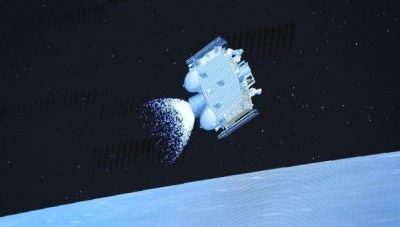China’s Spacecraft Takes off from Moon with Samples
The Change-5 probe had worked for about 19 hours on the moon. The samples were stowed in a container inside the ascender of the probe as planned.

The China National Space Administration (CNSA) announced that Change-5 probe carrying the country’s first lunar samples blasted off from the moon at 11:10 p.m. (Beijing Time) on Thursday.
Launched on Nov. 24, the Chinese spacecraft comprises an orbiter, a lander, an ascender, and a returner. Its lander-ascender combination touched down in the Ocean of Storms on Dec. 1. After the samples were collected and sealed, the ascender of Change-5 took off from the lunar surface.
“An engine, after working for about six minutes, pushed the ascender to preset lunar orbit,” said Xing Zhuoyi, a designer of the Change-5 probe from the China Academy of Space Technology (CAST).
Different from the ground takeoff, the ascender could not rely on a launch tower system. The lander acted as a temporary “launching pad.” The lunar liftoff conquered many challenges, including limited diversion space for the engine plume and different environments between Earth and the moon.
Without any navigation constellation around the moon, the ascender used its own special sensors to conduct self-positioning and attitude determination after the takeoff, assisted by the ground monitoring and control system.
Wonderful! From the China Moon landing yesterday!🌚👍 https://t.co/GsdoCeMTbA
— Steve Scharmer (@SScharmer) December 2, 2020
The spacecraft had worked for about 19 hours on the moon and finished its sampling work at 10 p.m. on Dec. 2. The samples were stowed in a container inside the ascender of the probe as planned.
It adopted two methods of moon sampling, including using drills to collect subsurface samples and grabbing samples on the surface with a robotic arm. It gathered diverse samples at different sites.
The ascender is expected to complete the unmanned rendezvous and docking with the orbiter-returner in lunar orbit, an unprecedented feat, and the samples will be transferred to the returner.
When the geometric relationship between Earth and the moon is suitable, the orbiter will carry the returner back to Earth. Change-5 is the world’s first moon-sample mission in more than 40 years.
*
Note to readers: please click the share buttons above or below. Forward this article to your email lists. Crosspost on your blog site, internet forums. etc.
Featured image: Photo taken at Beijing Aerospace Control Center shows the ascender of Chang’e-5 flying above the moon, Dec. 3, 2020. | Photo: Xinhua

